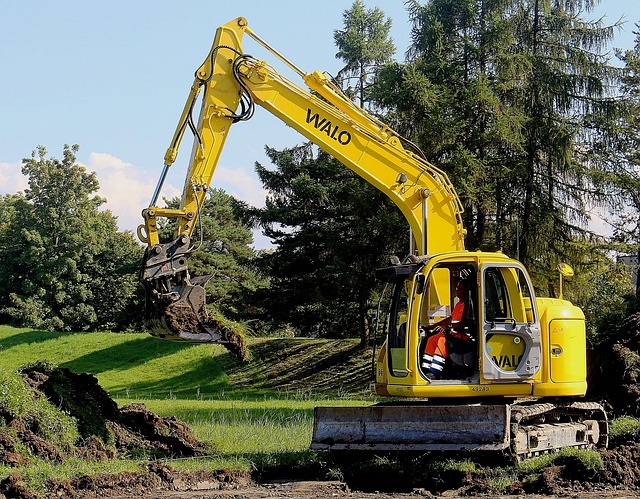Dynamic soil replacement transforms weak, saturated soils by driving coarse stone columns deep underground, boosting strength and reducing settlement. This technique enhances foundation stability without spoil generation, making it a cleaner, efficient solution for challenging ground conditions. Widely used in industrial and infrastructure projects, it offers a practical alternative to traditional methods, combining proven compaction principles with innovative displacement to revitalise your foundations effectively.
Core concepts and essential purpose of dynamic soil replacement in ground improvement
Dynamic Ground Replacement Services represent a proven method within ground improvement technologies, specifically developed for sites with compressible, organic, or weak soils. By harnessing the energy of falling weights, this technique forms compacted pillars of coarse stone or approved fill, directly enhancing the bearing capacity of soils that would otherwise limit development. These new, dense columns effectively bridge the gap between poor native ground and the structural demands of modern foundations.
Also read : Comprehensive asbestos surveys for safe building management
The fundamental principle lies in the use of repeated dynamic impact to drive granular material deep into the ground, leading to a hybrid of dynamic compaction and stone column techniques. As a result, a network of reinforcement pillars sometimes up to 3.5 meters in diameter—provides a reliable load-transferring skeleton within the treated layer. This process increases the soil’s internal friction angle, improves stiffness, and rapidly accelerates settlement, which is especially advantageous for time-sensitive construction.
The main engineering objectives address two core needs: foundation load capacity increase and settlement control. Applications are most impactful where soil improvement for foundations must contend with variability or marginal soils such as alluvial sites, filled ground, or locations prone to liquefaction. The approach allows for shallow foundation options and streamlines construction through minimal spoil production and environmental disturbance, making it an optimal choice for industrial zones, embankments, storage tanks, and high-load floor slabs.
Additional reading : Essential asbestos inspections for effective property safety
Dynamic soil replacement thus aligns with modern geotechnical engineering solutions: it delivers performance, sustainability, and cost-reduction, all while enabling robust, safe ground for future infrastructure.
How Dynamic Soil Replacement Works: Process, Materials, and Equipment
Dynamic soil replacement transforms soft, weak, or compressible ground by installing large-diameter stone columns using a systematic impact-driven method. Compaction trials come first: these determine the energy needed, the penetration depth, and the necessary aggregate volume for reliable soil densification process. Columns are formed step-by-step as tracked crawler cranes drop hefty weights—often from heights of up to 20 meters—onto prepared coarse aggregate on the surface. The weight displaces and mixes the aggregate into underlying soils, producing construction soil reinforcement pillars that improve load distribution and settlement behavior.
The dynamic ground treatment process alternates between compacting layers and adding more stone. Between 10% and 15% of the soil volume is replaced by coarse or recycled aggregates, supporting sustainability goals. These engineered materials not only bolster soil stability but also accelerate the soil consolidation techniques that underpin rapid settlement control and reduced liquefaction risks. Monitoring tools measure both compaction energy and depth to ensure soil structure integrity and verify project success.
Critical dynamic soil compaction equipment includes crawler cranes, drop weights, and field density gauges for quality assurance. Each equipment choice is tailored to site conditions—resulting in an adaptive, robust solution for challenging geotechnical environments.
Advantages and Unique Benefits Compared to Other Ground Stabilization Methods
Dynamic soil replacement benefits surpass many ground stabilization methods by focusing on foundation load capacity increase and rapid settlement reduction. Precision-based impact compaction forms dense, reinforced columns—allowing weak soil layers to support substantial structural loads without conventional deep piling or extensive excavation. This soil strength enhancement is especially valued for commercial, industrial, and infrastructure projects demanding consistent stability.
A major benefit lies in effective liquefaction mitigation. By generating stiff granular columns and improving soil gradation, the technique boosts resistance to seismic soil liquefaction. This soil liquefaction prevention provides crucial protection for regions prone to earthquakes or excessive groundwater, lowering risk during seismic events through a denser, more stable soil matrix.
The dynamic compaction benefits are not just technical. This method uses minimal or no spoil, making it environmentally conscious compared to other ground stabilization methods. The potential to use recycled aggregates further marks a shift toward sustainable construction. Improved ground permeability and expedited drainage support rapid consolidation, reducing the time infrastructure is exposed to settlement risk.
Cost savings are realized as the process minimizes additional earthworks and disposal, and the versatility allows tailored solutions for diverse soils—maximizing long-term soil improvement efficiency and durability while meeting economic and environmental goals.
Suitability Criteria: Soil Types, Site Conditions, and Selection Factors
Soil improvement for foundations using dynamic soil replacement relies on a precise soil suitability assessment. Dynamic techniques excel in deep soil replacement methods when faced with organic, peaty, or soft compressible soils, as well as fills with high fines content. In these contexts, granular soil improvement delivers robust load-bearing columns, improving both shear strength and settlement performance.
Professional construction site soil management begins with careful site preparation for soil replacement. Soil suitability assessment considers soil gradation, compressibility, permeability, and existing groundwater conditions. Optimal outcomes require adjusting compaction energy parameters and granular fill content, ensuring dynamic methods reach the intended depth and density for each project.
Site-specific selection factors extend to structural loading requirements, footprint size, and project timelines. Ground improvement suitability is highest where shallow foundations and rapid settlement control are necessary, making dynamic soil replacement preferable over deep piling or mass excavation.
Dynamic soil replacement risks center on inappropriate soil types (such as dense, gravelly substrates), insufficient compaction energy, or poor quality control. It is crucial to implement soil compaction quality control and thorough dynamic soil replacement monitoring. Regular soil density and settlement testing guides safe, compliant work while supporting sustainable, long-term performance.
Detailed Process Stages and Site Execution Workflow
Dynamic soil treatment planning demands thorough site investigation. Initial project planning for soil improvement involves detailed geotechnical assessment, mapping weak zones, and organizing health and safety protocols. The site preparation for soil replacement includes constructing a safe working platform and staging the necessary dynamic soil compaction equipment well in advance.
In execution, on-site trials are conducted to refine compaction energy parameters, using controlled test drops to calibrate impact energy and optimize soil consolidation techniques for the encountered strata. Staged filling and pounding deploy granular materials in layers; each sequence is carefully monitored using advanced compaction testing methods to ensure consistent pillar formation and targeted soil densification.
Energy management becomes crucial during this phase for effective soil consolidation techniques, minimizing uneven settlement. The workflow alternates between high-energy impacts to deepen columns and lighter surface compaction to stabilize near-surface soils. Soil compaction quality control teams track real-time data, adjusting procedures to maintain uniform ground structure.
Ongoing soil settlement monitoring and post-execution dynamic soil replacement monitoring verify that required load-bearing standards are met. Ground settlement control is sustained through periodic surveys, while compliance with soil compaction quality control standards assures long-term performance and efficient ground stabilization.
Key Applications and Real-World Project Examples
Dynamic soil replacement applications demonstrate exceptional adaptability in commercial, industrial, and infrastructure contexts. For instance, in ground improvement case studies involving warehouses and wind farms, the technique consistently enhances foundation load capacity increase and enables the use of shallow foundations, increasing soil improvement efficiency for large-scale floors and embankments.
In infrastructure soil improvement, dynamic soil replacement supports the stability of roads, water treatment facilities, and energy installations. These projects often encounter compressible or saturated soils—conditions previously requiring more invasive strategies. By applying dense soil matrix formation and advanced soil strength testing during and after installation, engineers document significant reductions in settlement and measurable soil structure integrity improvements.
Heavy structure foundation solutions—such as storage tanks and high backfill zones—benefit from this method’s ability to create high internal shear resistance columns within weak subsoils. Real-world cases highlight the application’s efficiency: the technique has provided settlement control and soil strength enhancement at major distribution parks, large retail hubs, and embankment upgrades.
Lessons from dynamic soil replacement applications underscore its value for ground settlement control and soil bearing capacity optimization—even in hostile terrains. Continuous monitoring and post-compaction soil testing ensure dense, improved foundations for demanding engineering environments through repeatable, high-performance dynamic soil replacement applications.
Design Considerations, Standards, and Cost Factors for Dynamic Soil Replacement
Dynamic replacement engineering principles are governed by established soil replacement compliance standards, which ensure that each phase adheres to precise ground improvement technologies. Project planning for soil improvement demands rigorous analysis of soil profiles, foundation load capacity increase, and the potential for soil modulus enhancement. Meeting these soil replacement compliance standards is essential for ensuring the dense soil matrix formation required for reliable load transfer and consolidation.
Design and specification guidelines reference compaction energy parameters, aggregate gradation, and anticipated soil structure integrity. Key variables—such as native soil types, groundwater presence, and compaction layer thickness—directly influence dynamic replacement cost factors. Conditions like organic or high-moisture soils can require more intensive dynamic soil compaction equipment use, affecting soil improvement project cost due to additional material volume and equipment operation.
Sustainable soil stabilization practices integrate recycled aggregates to lower environmental impact and optimize soil stabilization materials. Efficient design supports shorter dynamic soil replacement timelines and reduces vibration-induced soil settlement risks, aligning with long-term ground settlement control and environmental impact of soil replacement. Innovative earthworks optimization leverages real-time dynamic soil replacement monitoring and soil compaction quality control to maximise both immediate and enduring dynamic soil replacement benefits.










